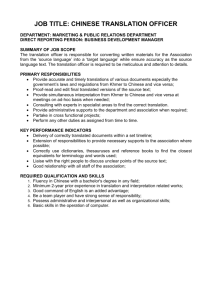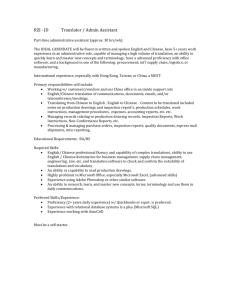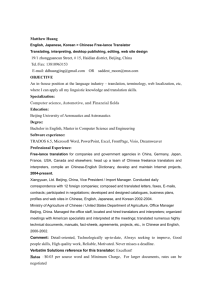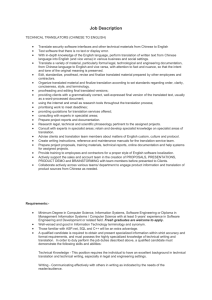Cultural untranslatability in translations from English to Chinese
advertisement
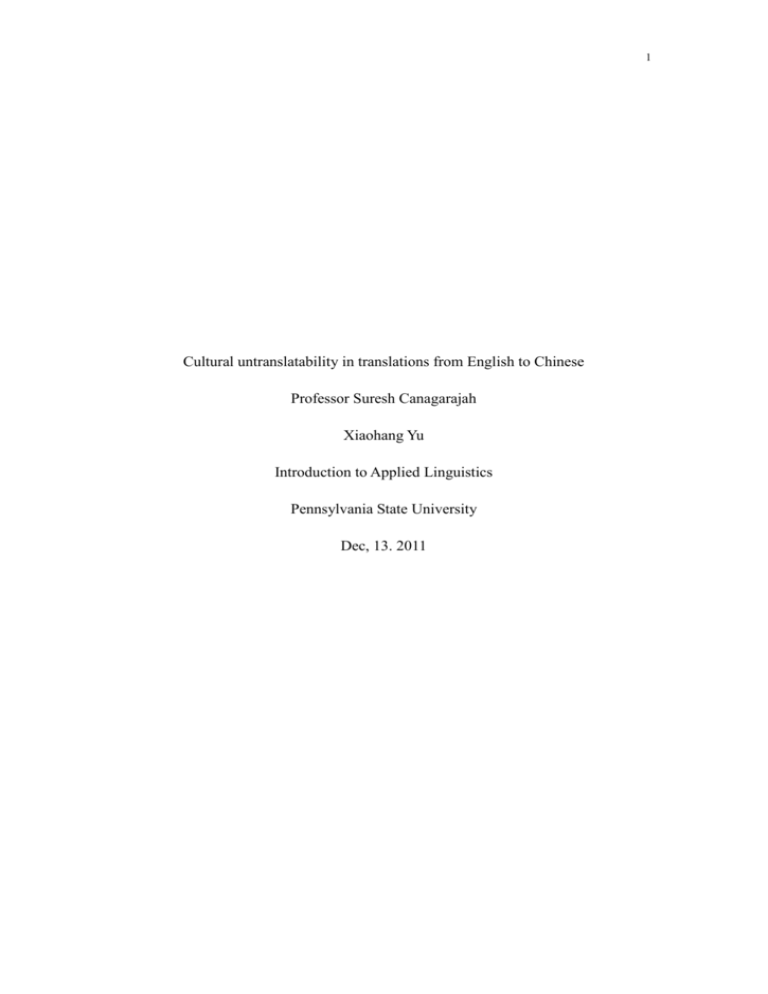
1 Cultural untranslatability in translations from English to Chinese Professor Suresh Canagarajah Xiaohang Yu Introduction to Applied Linguistics Pennsylvania State University Dec, 13. 2011 2 Cultural untranslatability in translations from English to Chinese As Cook has said, applied linguistics sets out to investigate problems in the world in which language is implicated. (2003, p.5) One of the important problems which is close to human life while can not be solved for quite a long time is that groups or individuals who speak different languages can not communicate each other. Translation, and translation studies, as the solution of this problem, has been highly developed and discussed by applied linguists. Trivedi mentioned that traditionally,translation was seen as a segment or sub-field of Linguistics, on the basic premise that translation was a transaction between two languages. (2005) Before that, Nida and Taber claimed in the book The Theory and Practice of Translation that translating means reproducing in the receptor language the closest natural equivalent of the source-language message in terms of meaning and style. (1969) However, because of the language origins and characters, culture and history are totally different in different languages and societies, it is hard to translate everything precisely from one language to another. The idea of "untranslatability" was supported by Catford, who classified it into two categories in his book in 1965, which are linguistic untranslatability (LU) and cultural untranslatability (CU). This paper will only focus on the analyse of CU. Catford summarized the reason of CU as "when a situational feature, functionally relevant for the source language (SL) text, is completely absent from the culture of which the target language (TL) is part" (1965,p.99). Cultural connotation and feature are shaped under the historical condition, and influenced by the 3 geographical environment, life styles and customs, and social development. Because of those differences in different countries, cultural diversity is obvious especially in terms of values, ways of thinking, esthetic sentiment, which also causes the untranslatability with the context related to culture. Chinese and Western culture are distinctive and most commonly contrasted by scholars, so the CU in translations between English and Chinese is obvious and worth developing in order to communicate with each other because of globalization. In the following of this paper, this issue will be discussed from the aspect of translating English into Chinese by providing examples. 1. Proverbs, colloquialisms and idioms Proverbs and idioms are the important aspects of linguistic culture in a country, because they are derived from the country's geographical environment or historical culture and development. If Chinese does not share the same geographical/historical background with the western ones, then the English proverbs and idioms can not be translated into Chinese directly. Some idioms are influenced by the geographical environment of the country or district. There is a English saying, "spend money like water", which is used to describe a person spend money lavishly. The reason why the word "water" is applied is mentioned by Xu (2006), which explains that the UK is an island and its navigation was in the lead of the world historically. So water becomes the identical and representative feature of the country. Therefore, a lot of idioms are related to water. Another example is "at all sea", which expresses a person is at a loss. However, when 4 the idioms above are translated into Chinese, only the connotation meaning can be translated instead of the denotation meaning with regard to water. The reason is that China is located in the Asia continent, and most of the Chinese people live on earth and agriculture in the history. So earth plays an important role in Chinese culture. When Chinese scholars translate the idiom "spend money like water", they would use "earth" to express the action, not "water". There are great amount of history and culture of the nation exist in the colloquialisms, so the CU would happen if those content of source language do not exist in the target language. In western countries, dog is the regarded as human's friend, and it is also the representatives of loyalty. A great amount of colloquialisms and proverbs use the image of dog to approve a person or express positive meaning. The most common examples are "Love me, love my dog" and "a lucky dog". However, it can not be translated into Chinese literally. Because in China, the image of dog is always related to inferior level of people or negative representation. So, in Chinese, "love me, love my dog" is translated as "if you love my house, you have to love the raven on the roof of my house, even though they are not good symbols", the connotation meaning is remained while it has nothing to do with "dog". In her paper "Untranslatability from Culture Perspective and Relevant Translation Strategies", Yu also provides a good example. The idiom "let the cat out of the bag" in English is derived from a old story: "The pig seller put a cat in the bag in order to trick buyers that it was a pig in it. However, when a buyer comes to him, the cat jumped out of the bag by itself." When this idiom is translated into Chinese, we 5 can only convey its meaning behind the story, which is "to tell a secret", so the readers do not have the chance to understand and enjoy the funny story. 2. Proper names and nouns Basicly, English proper names and nouns are translated into Chinese by transliteration, paraphrase, or combine them together. It seems that those translation methods could solve most of the situation, but there are still some problems about CU when translating proper names and nouns. The first case is about the translation of the names of countries. Many countries' names derived from the history and implied certain significant meaning. For example, Argentina was once the place where Spanish colonists wanted to conquer and occupied because it was a kingdom of silver, and the word "silver" in Spanish is "Argentum", then the name of this country --"Argentina" appeared; Columbus was the first European navigator who navigated to America, and the country "Columbia" was named to commemorate him. However, when translating the countries' names into Chinese, scholars and translators mostly use the method of transliteration. As a result, Chinese people can only know the general pronunciation of the countries' names, but have no idea about the story and history behind them. Another example that I think of is the translation of brand names. Android, which is an operating system for mobile system. The word "android" first appeared in the science fiction L'ève future, the French author Auguste Villiers de l'Isle-Adam used this word to represent the machines which have human appearance. Andy Rubin, the founder of android operating system, chose the word "android" because of his love 6 of robot. And it seems that this word also implies the strong and diversified functions of android system just as what a robot can do. When translating "android" into Chinese, the transliteration is employed. Although the translator chose the Chinese characters with the meaning of "steady and predominant" to name and describe android operating system, the robot story behind the name still can not be discovered by many Chinese people from the Chinese translation. There is also hidden cultural information behind the translation of American coins. The most common coins are cents, nickels, dimes, and quarters, and their translation of Chinese are the corresponding denominations: one cent, five cents, ten cents, and twenty-five cents. While, Americans use the word "nickel" to represent five cents because those kind of coins are made of nickel. Therefore, Chinese may not get this information by the translation of nickel coins. 3. Time and measurement Some related discussion can be found in Juan's paper "To translate or not? There is a culture problem". Juan proposed that the great difference exist between western and Chinese people when they express time: the former use subtraction while the latter use addition. For example, if a clock shows now it is 8:45, western people would say "it is a quarter to nine." However, it may not be translated into Chinese directly since it is not the common way to say it and would be weird for Chinese people. So the more appropriate way to express this time in Chinese would be "it is eight forty-five." 7 Since different measurement units are used in different countries and areas, in order to make readers better understand the context, switching among them is necessary when translating western measurement into Chinese. In US and some other western countries, inches, feet, and pounds are the units of height and weight, while meters and kilograms are used in China; the former use miles for measuring distance, while the latter use kilometers; for temperature measure, US uses Fahrenheit while Celsius is used by China. We need to pay attention to those measurement units during the process of translation. If they are translated into Chinese literally, Chinese readers and listeners would be confused about the data since they are not familiar with the measurement units of US, and may cause problems for understanding the context since numbers always convey important information. Therefore, translators should convert the units to the ones that Chinese use and then translate them into Chinese. Conclusion In order to reduce the loss of cultural information during the translation, CU requires translators to find some reasonable and effective ways to convey the cultural information of SL as much as possible. American scholar, Lawrence Venuti, proposed "the foreignization and domestication method" in his book The Translator's Invisibility: A History of Translation in 1995. Foreignizaion implies that translation should retain as much SL culture as possible, and let readers understand the culture difference, while domestication needs translators to select expressions which the readers of TL are familiar with for conveying the content of SL. Moreover, if an 8 equivalent word can not be found in TL, explanatory notes can be added at the foot of the pages, and this is an effective way to preserve the SL culture. From what have been discussed above, English and Chinese have many different linguistic and cultural characters, which cause CU during the process of translation. However, from the discovery of related topics, it is obvious to see that the great problem only appeared at the first time of translation. With the deeper communication of different cultures, scholars and translators develop assistant ways to overcome the difficulties and make the cultural communication successful. Because of the frequent and deep cultural exchange, the CU in translations between English and Chinese can be translated in the future. 9 Reference Cook, G. (2003). Applied linguistics. Oxford: Oxford University Press. Catford, J. C. (1965). A Linguistic Theory of Translation: An Essay in Applied Linguistics. London: Oxford University Press. Juan, Rachel. (2008). To translate or not? There is a culture problem. Undergraduate Program in European Languages, Master Program in European Studies, 01, pp. 87-106. Nida, E. & Taber, C. (1969). The Theory and Practice of Translation. Leiden: E. J. Brill. Trivedi, Harish. (2005). "Translating culture vs cultural translation". Paul St-Pierre and Prafulla C. Kar (eds.) In Translation. Reflections, refractions, transformations. Delhi: Pencraft International. pp.251-260. Venuti, Lawrence. (2005). The Translator's invisibility: A History of Translation. London & New York: Routledge. Xu, Qinying. (2006). On Influence of Cultural Difference on the Translation of English--Chinese. A Wide Range of Cultural History/ Theory, 04, pp. 29-30. Yu, Honghua. (2008). Untranslatability from Culture Perspective and Relevant Translation Strategies. Journal of Yibin University, 10 (10), pp.99-101.
